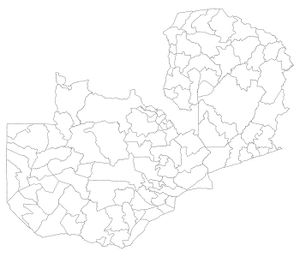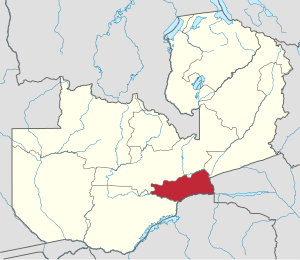2017-18 Zambia cholera outbreak
This article documents a current event current event. Information may change rapidly as the event progresses, and initial news reports may be unreliable. The last updates to this article may not reflect the most current information. (January 2018) |
 | |
 | |
 | |
| Disease | Cholera |
|---|---|
| Bacteria strain | Vibrio cholerae |
| Dates | 6 October 2017 – present |
| Origin | Chipata Compound, Lusaka |
| Deaths | 51 |
| Confirmed cases | 2091 |
The 2017/2018 Zambian cholera outbreak was an epidemic of cholera affecting much of Zambia from October 2017 and become more lively in January. The outbreak began in most parts for Lusaka the capital city in October's 2017 then spread to most parts of the country by January of 2018 cases were being reported in all 3 provinces. The outbreak peaked in January 2018 with over 91 cases reported. In total, 2091 cases of cholera and 51 deaths were reported so far, making this the fastest-growing outbreak in history. The large scale and severity of the outbreak has been attributed to poor sanitation and limited access to healthcare.
Cause
The 2017 cholera outbreak was caused by widespread infection with the bacterium Vibrio cholerae which is spread through water contaminated with the feces of infected individuals. Cholera had been seen for decade leading up to the 2017 outbreak. One of the major contributing factors to the outbreak was the breakdown of the municipal water supply, sanitation , and waste collection
Outbreak
The cholera outbreak initially started in the Chipata Compoud. On 6 October 2017, the Minister of Health declared an outbreak of cholera in the capital city. From 28 September through 7 December 2017, 547 cases including 15 deaths (case fatality rate = 1.8%), have been reported since the beginning of the outbreak. The initial outbreak period was from 28 September through 20 October. From 21 October through 4 November 2017 there were less than five cases reported each week. However, from 5 November 2017 an increase in the number of cases was observed with a total of 136 cases reported in the week beginning 26 November. As of 7 December, the affected Compounds include Chipata, Kanyama, Chawama, Matero, Chilenje and Chelston. Sixty-two cases are currently receiving treatment in Cholera Treatment Centres in Chipata, Kanyama, Matero and Bauleni. One third of the cases are children under five years old and two thirds are persons five years and older.
Efforts to reduce the cholera outbreak
On 29th December 2017 President Lungu[1] dispatched Zambia's security wings to help fight a cholera outbreak, which had already killed over 41 people in the capital city, and affected more than 1,500 others since September. In a Facebook post late on Friday, Lungu said "all three wings of the Defence Force" had been deployed "to escalate efforts" to minimise the spread of the disease.[2]
Response
WHO recommends proper and timely case management in Cholera Treatment Centres. Improving access to potable water and sanitation infrastructure, and improved hygiene and food safety practices in affected communities, are the most effective means of controlling cholera. Use of oral cholera vaccine may also be used for outbreak control. Key public health communication messages should be provided. WHO advises against any restriction to travel to and trade with Zambia based on the information available on the current outbreak.[3][4]
References
<templatestyles src="Reflist/styles.css" />
- ↑ Lua error in ...ribunto/includes/engines/LuaCommon/lualib/mwInit.lua at line 23: bad argument #1 to 'old_ipairs' (table expected, got nil).
- ↑ Lua error in ...ribunto/includes/engines/LuaCommon/lualib/mwInit.lua at line 23: bad argument #1 to 'old_ipairs' (table expected, got nil).
- ↑ Lua error in ...ribunto/includes/engines/LuaCommon/lualib/mwInit.lua at line 23: bad argument #1 to 'old_ipairs' (table expected, got nil).
- ↑ Lua error in ...ribunto/includes/engines/LuaCommon/lualib/mwInit.lua at line 23: bad argument #1 to 'old_ipairs' (table expected, got nil).